In the first few months your baby will just need breast or formula milk to meet all their nutritional needs. As they grow they will gradually move onto eating solids.
It’s an exciting time but one which you may have many questions about too. Here is everything you need to know about how to start weaning and how best to make the move from milk to solids.
How do I know my baby is ready for weaning?
Official advice from the World Health Organisation is to exclusively breastfeed your baby and hold back on introducing solids until 6 months.
However many parents choose to start weaning a little earlier if they feel their baby is ready for more than milk alone. They might notice their baby staring or grabbing food, draining their milk feeds and wanting more or waking more at night when they were previously sleeping well.
For more information on early weaning and whether it’s for you, take a look at our article When is the best time to wean baby? which goes into this in more detail.
NHS advice is that parents should look out for these three signs that your baby is ready for weaning:
- They can sit up and hold their head steady
- They can coordinate their eyes, hands and mouth so that they can pick up food and bring it to their mouth
- They can swallow food.
If you think your baby is ready to start weaning before 6 months discuss it with your health visitor. Solid foods should not be introduced before 4 months.
What equipment do I need to get going?
You really don’t need an awful lot of equipment to start your weaning adventure. The following are all useful to get you off to a good start.
- High chair. It’s best to get one that is easy to wipe down and clean. Ones with removable trays are useful as well.
- Plastic weaning spoons and bowls. Check that these are dishwasher friendly and BPA free.
- Bibs. Buy lots as you’ll go through them quicker than you can wash and dry them. Plastic bibs with a lip are good at the start to catch any fallen or spat out food.
- Plastic sippy cups. From 6 months on, you can give your baby a plastic cup with water to drink from. Ones with handles that baby can grab onto work great.
- Blender or baby food maker. A blender in particular is essential for pureeing food. A baby food maker generally has functions that both steam and puree the food and can make food preparation easier but is not essential.
- Ice cube trays. You can cook up lots of fruit and veg and then pour them into ice cube trays and freeze them.
- Storage pots (with lids). Handy to keep food in the fridge, freezer or to take it with you when you’re out and about.
- Shower curtain or plastic mat. A top tip is to buy a cheap shower curtain to pop under your baby’s high chair and the place where they will sit to eat. That way you can easily whisk away and wipe up any spillages.
How do I introduce those first bites of solids?
To begin with weaning is all about introducing your child to the act of eating rather than about them consuming lots of calories and nutrients.
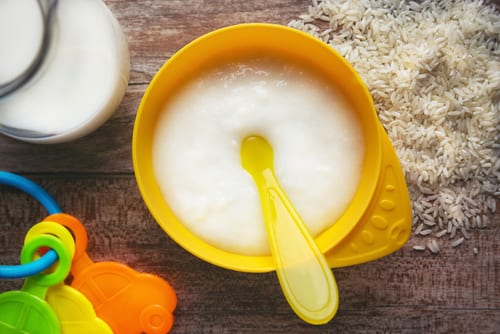 When you start, keep feeding your baby keep up their usual milk feeds as they are. Between these milk feeds introduce them to a small portion of solids made up of smooth and easy to digest foods.
When you start, keep feeding your baby keep up their usual milk feeds as they are. Between these milk feeds introduce them to a small portion of solids made up of smooth and easy to digest foods.
Many parents choose to give baby rice as a first introduction. It’s a good way of letting your baby try a new texture but still with a familiar milky taste.
Baby rice comes as a dry powder, which you simply mix with breast or formula milk. You can make the mix quite runny at the start and over the days and weeks make it gradually thicker.
Once your baby has got used to eating baby rice from a spoon you can move swiftly onto introducing pureed fruit and vegetables.
Most parents just use baby rice for a few days to prepare baby’s tummy for solids. Other parents choose to begin with pureed fruit and vegetables straight away.
You don’t have to start weaning with baby rice. But it is a nice easy way to start the weaning process.
Baby’s first meals
You can skip baby rice altogether and start by introducing pureed fruit and vegetables as your baby’s first foods. The ideal ones to try at first are those that are mild and easy to digest, such as apple, pear, sweet potato and carrot.
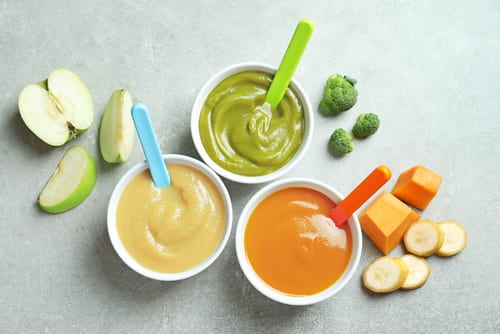 Peel your fruit or veg and then boil or steam them until they are soft. Don’t add any salt or sugar to the water. Then whiz them with a blender until they are smooth with some water or with baby’s usual formula or breast milk. You can add more or less water to get the consistency you need.
Peel your fruit or veg and then boil or steam them until they are soft. Don’t add any salt or sugar to the water. Then whiz them with a blender until they are smooth with some water or with baby’s usual formula or breast milk. You can add more or less water to get the consistency you need.
Leave the food to cool a little and then offer your baby some on a plastic weaning spoon. They will probably just need a few spoonfuls to start with.
Try offering just one new food a day and offer any new foods in the morning or early afternoon so that you can check that there are no allergic reactions. You want to avoid introducing new foods right before baby’s bed time or nap time.
Once baby is used to this new food you can keep offering it to them a few times a week.
If you struggle to cook baby’s food from scratch for each meal then a great time-saver is to cook up a batch of pureed food. Pop it in small containers or ice cube trays and freeze it. It’s then ready for you to pop out and heat up for baby’s meal.
How often should I give my baby solids?
On your very first day pick a time, such as a lunchtime feed, or breakfast feed, to give your baby their first taste of solids. This is just a taster and you should continue to give your baby her usual milk feeds as you start the weaning process.
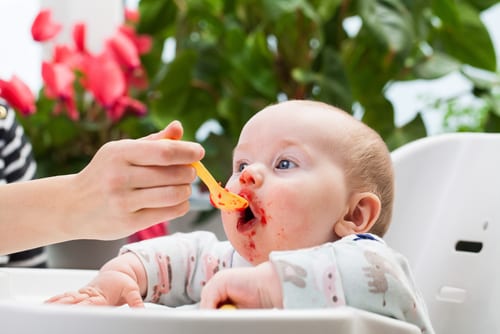 For the first couple of days just offer your baby a few spoonfuls of runny baby rice or puree. Some babies will yum them up straight away. Others take a little longer to get used to the new tastes and to the new experience of being spoon fed.
For the first couple of days just offer your baby a few spoonfuls of runny baby rice or puree. Some babies will yum them up straight away. Others take a little longer to get used to the new tastes and to the new experience of being spoon fed.
Don’t worry if your baby doesn’t seem to eat a lot at this stage. It’s all about trying new flavours and learning about eating solids and they’ll still be getting most of their nutrients from their usual milk feeds.
After a couple of days you can try offering your baby a couple of spoonfuls of puree at their teatime feed too.
For the first few weeks keep offering your baby solids twice a day, between milk feeds. Gradually introduce lots of new and different foods and flavours every couple of days.
Your baby might seem to prefer some foods and spit out others. Don’t feel you have to take any refused foods off the menu. Just try them again in a few days. It can take many tastes for a baby to like a new food so keep persevering.
What your first week might look like
Here is a rough feeding schedule to give you an idea of when to feed your baby their first solids. You can adapt this to suit your baby’s feeding patterns or preferences.
Choose any soft fruit and vegetables and introduce a new one every day or every few days.
The important thing to remember at this stage is that your baby will still be getting her usual milk feeds and will be trying some new runny solid foods too.
| Day / Feed | 7am | 9am | 11am | 3pm | 5pm | 7pm | 10pm |
| Monday | Milk | Baby rice or pureed apple | Milk | Milk | Milk | Milk | Milk |
| Tuesday | Milk | Baby rice or pureed pear | Milk | Milk | Milk | Milk | Milk |
| Wednesday | Milk | Baby rice or pureed apple and pear | Milk | Milk | Baby rice or pureed carrot | Milk | Milk |
| Thursday | Milk | Baby rice or pureed plum | Milk | Milk | Baby rice or pureed sweet potato | Milk | Milk |
| Friday | Milk | Baby rice or pureed apple and banana | Milk | Milk | Baby rice or pureed broccoli | Milk | Milk |
| Saturday | Milk | Baby rice or pureed peach | Milk | Milk | Baby rice or pureed parsnip | Milk | Milk |
| Sunday | Milk | Baby rice or pureed mango | Milk | Milk | Baby rice or pureed peas | Milk | Milk |
 Add some finger foods
Add some finger foods
If your baby is over six months old you can give them some soft finger foods for them to pick up and explore at mealtimes.
Cut up some baby foods into long, thick batons. It’s good if the pieces area nice size for your baby to grab and hold in their fist with enough sticking out to chew on.
Use your own finger as a guide for the right size to cut foods into. You can try finger foods such as grabable pieces of avocado, cooked broccoli or soft cooked carrots.
Pop some finger foods on the table or high chair for your baby to pick up and explore as a side to the pureed food you are offering them.
Top tips to get weaning off to a good start
- Don’t worry if your baby doesn’t seem to eat very much at first. It’s all about experiencing new foods and textures at this stage. A few spoonfuls is often plenty when you start weaning.
- Keep offering different foods. Your baby will naturally have a sweet tooth because milk is sweet, so they may prefer sweeter foods, such as apples and pears. They might make faces or spit out savoury food at first. Don’t worry. At the beginning it’s all about exploring different flavours. Keep offering each new food several times. Try to vary meals between sweeter fruits and savoury vegetables so that they can start to enjoy savoury foods too.
- Be prepared for the mess. Weaning is a messy business. Be prepared by making sure you feed your baby in an area that’s easy to wipe clean and use bibs to mop up any spills. Have some baby wipes handy.
- Let your baby touch and hold food. They might squish it and smear it but it’s all part of exploring the smells and textures. Hopefully they will try a bit too.
- As soon as your baby shows interest let them pick up their own finger food and feed themselves.
- Let your baby go at their own pace. If you’re spoon feeding wait for them to open their mouth before popping in the spoon.
- If you’re spoon feeding your baby might like to hold their own spoon in their hand too, so have an extra one to hand.
Next foods
Once your baby has got used to eating pureed fruit and veg from a spoon you can begin to introduce new foods and flavours and make their food more textured.
 If you start weaning at six months you might give them different fruits and vegetables for the first 2 or 3 weeks and then start introducing some different foods like meat and fish too.
If you start weaning at six months you might give them different fruits and vegetables for the first 2 or 3 weeks and then start introducing some different foods like meat and fish too.
If you start weaning earlier then stick to fruit and vegetables until they are 6 months old and after that you can add in some more variety.
After 6 months your baby can have soft cooked chicken, white fish (make sure there are no bones), pasta, lentils, and cooked rice and pasta.
The NHS advises that babies from 6 months and over can have some dairy products such as cows milk, yoghurts and eggs in their foods. However milk feeds should not be cow’s milk until they reach 12 months of age. Some parents prefer to delay introducing dairy entirely until baby is 1 year old but that is a personal choice.
You can also start combining foods. For example you might mix chicken with sweet potato to make a delicious baby casserole.
Once your baby is coping well with smooth purees then make their meals gradually more textured. You can now mash their food with a fork instead of blending it so they get the experience of trying a few small lumps. Gradually over a number of months they may move onto eating soft chunks.
Common food allergies
It’s good to introduce your baby to a variety of foods with different tastes and textures. However there are certain foods linked with allergies, that it’s worth taking particular care with.
For these foods wait until your baby is at least 6 months old, introduce each of these foods on their own and at a time when you can keep an eye on your baby to check for any reactions.
Don’t introduce these before a nap or night time sleep as you may not become aware of a reaction.
- Cow’s milk and dairy. Your baby should not have this as a drink before 12 months but you can offer things like yoghurt and cheese from 6 months.
- Eggs
- Gluten. Food containing gluten, such as bread or pasta or anything with wheat.
- Fish and shellfish
- Tree nuts (most nuts are tree nuts: brazil nuts, almonds, cashews, macadamia nuts, pistachios, pine nuts, walnuts)
- Peanuts
- Seeds
- Strawberries
- Kiwis
- Soy
Foods to avoid
Avoid giving your baby these foods, until they are at least 12 months old:
- Honey – very occasionally it can produce toxins in a baby’s intestines and cause infant botulism. This can be serious so avoid honey entirely.
- Salt – don’t add any extra salt to your baby’s food or use salt when cooking. Avoid very salty foods, such as Marmite. Your baby’s kidneys are not developed enough yet to cope with too much salt.
- Whole nuts – they are a choking hazard. No child under 5 should eat unchopped nuts.
- Whole grapes. Grapes are a wonderful first food but unfortunately their shape and size can make them a significant choking hazard also. If you’re not blending them into a puree then always cut grapes into halves or quarters before giving to baby. Again do not offer whole grapes to a child under 5.
- Shark, swordfish and malin – they can contain high levels of mercury, which your baby’s body wouldn’t be able to cope with.
- Raw shellfish. You can, though, introduce cooked shellfish after 6 months
- Mould-ripened cheese (such as brie or silton) or unpasteurised cheese. Again your baby’s digestive system is not ready to cope with them yet.
- Citrus fruits such as oranges, lemons, limes, grapefruits and tangerines as well as other ‘acidic’ foods. These can upset baby’s stomach and cause terrible nappy rash. If you really want to try them then after 9 months of age you could offer them a cut up segment or small taste of it and keep an eye on them for any reaction.
However you choose to get started you’ll love seeing baby’s first reactions to all the new and wonderful tastes they’ll be trying.
Some foods they will lap up and others they will pull funny faces at with each bite. Either way enjoy their food explorations right along with them!

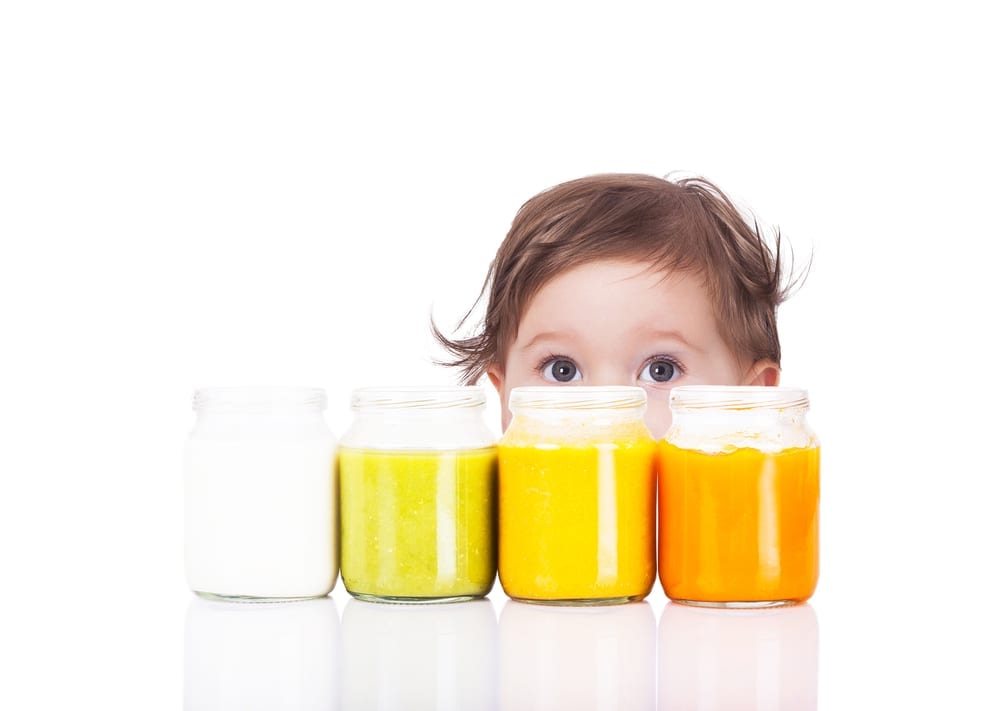
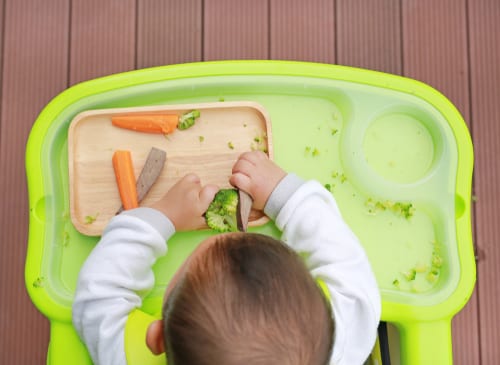 Add some finger foods
Add some finger foods